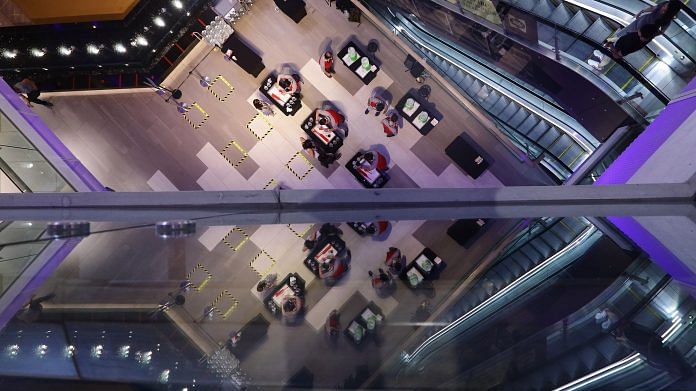Once lauded as a beacon in the fight against Covid-19, Singapore reached an unenviable milestone this week: the most cases in Southeast Asia.
Soaring infections suggest rapidly tightening restrictions on social and economic activity are unlikely to cease anytime soon; the prime minister said Tuesday that schools and most workplaces will remain closed until June 1. The struggle to contain this pandemic even in a well-run, rich nation casts doubt on whether any country can become a global standard-bearer.
Singapore has 9,125 coronavirus cases as of Tuesday, a tenfold increase in just three weeks, though has reported just 11 fatalities. That’s a blip compared with Indonesia’s 616 deaths, the Philippines’s 437 and Thailand’s 48. The bulk of new infections are from the migrant-worker community, which resides in tightly packed dormitories. These laborers hold many of the lower-paid jobs vital to Singapore’s first-world economy.
While the surge likely reflects more comprehensive testing than neighbors, this is an uncomfortable position for a place that usually runs like a Swiss watch. In return for its strong executive powers, the elected government has long provided policy stability, predictable decision-making and maintenance of health and wealth. Per capita income is among the highest on the globe and Singapore’s health system is in the top 10 worldwide, according to a 2019 Bloomberg analysis.
Also read: Ventilator demand makes Singapore’s richest man richer by $3.5 billion
Singapore’s attention to procedure can chafe, but its methodical approach is often preferable to the haphazard administration that can characterize much of Southeast Asia. That’s part of what’s made the past few weeks so jarring.
Having navigated through Severe Acute Respiratory Syndrome in 2003, the government warned its citizens early of the risks from Covid-19. Singapore was among the first to restrict arrivals from China; temperature screenings at offices and restaurants became commonplace by February. For months, the government urged citizens only to use masks if unwell. But as the case count rose, the government changed its tune, and stopped discouraging healthy people from wearing them. That later evolved into an order: Wear a mask, or risk fines and prosecution. (Children under two and exercisers have been exempt.)
It wasn’t until the government’s early April “circuit breaker” — the term lockdown is frowned upon — that schools were shut. By that point, more than 160 nations had taken this step. The new restrictions also closed most businesses, aside from essential services. Fines are administered for people perceived to be breaching distancing rules; social gatherings with people outside your household have been outlawed, even inside private homes. Restaurants can sell food for takeout or delivery, but loitering is prohibited. After months of gradual limits on activity, officials hit the fast-forward button. New curbs were unveiled Tuesday, at the halfway point of the initial month-long circuit breaker that was scheduled to end early May. Access to wet markets and supermarkets will be restricted. Residents are advised to go out alone, rather than with family members, and stick close to home.
You could point to the lack of stricter measures to date for the rapid increase. But in retrospect, the 43 foreign-worker dormitories were an accident waiting to happen. Conditions in these housing units meant that once the virus got a toehold, swift transmission was inevitable. Tommy Koh, former Singaporean ambassador to the United Nations and the U.S., has criticized the state of workers’ living quarters. In an open letter to his grandchildren, published in the opinion pages of the Straits Times, he wrote:
“The sixth group of people we should praise are our indispensable foreign workers, such as our domestic helpers, cleaners, construction and shipyard workers, and others who work in jobs that Singaporeans are not prepared to do. We owe the foreign workers an apology for the atrocious condition of their dormitories.”
The government has responded quickly. Testing among migrant workers is widespread and will be stepped up, affected dorms are being isolated and healthy laborers are being housed in repurposed convention centers and military facilities. Ministers pledged to care for them and have acknowledged the essential nature of their work. Late Tuesday, the government said the migrant workers will be required to stop going to work and stay in their dorms.
For its part, Singapore has never laid claim to being a model in the battle against the virus, though Prime Minister Lee Hsien Loong did note that the World Health Organization lauded its response in a March 12 address. In an interview with CNN later that month, host Fareed Zakaria invited Lee to explain the country’s success. The premier balked at any talk of victory and predicted a long struggle. “I know this has not been an easy time for everyone,” Lee said Tuesday. “We are making progress, but we have not yet succeeded.”
Perhaps the best lesson from Singapore is that there is no single playbook to combat an adversary that disregards boundaries. Even the most efficient and risk-averse countries have been sideswiped. The pandemic responses of the future may wind up splicing together the most effective steps taken around the world — unfortunately, that’s a template we may not see for years to come.
Also read: How Singapore flipped from virus hero to cautionary tale



